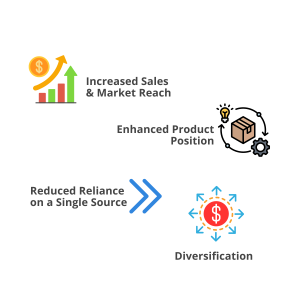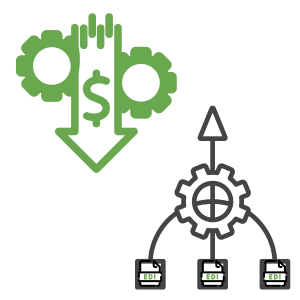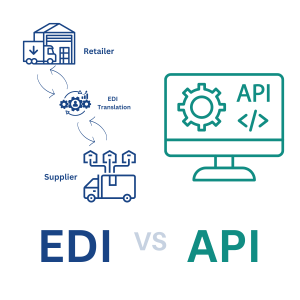Define EDI Integration
EDI integration means setting up a full EDI workflow between trading partners to exchange business documents. This includes establishing endpoints, protocols, and EDI document transactions that you exchange with your trading partner and also translating those documents into a format that can be used by your internal order management, ERP, or accounting systems. Thus, integration enables the seamless transfer of EDI data to and from other systems, eliminating the need for manual data entry and reducing errors.
In today’s digital world, businesses that are utilizing EDI technology to their fullest are the ones who are achieving an exceptional increase in their supply chain operational efficiencies by automating the entire process of EDI document exchange and improving overall trading partner relationships by achieving 100% EDI compliance.
Types of EDI Integration
There are 3 types of EDI integrations.
- Direct EDI Integration
- Indirect EDI Integration
- Hybrid EDI Integration
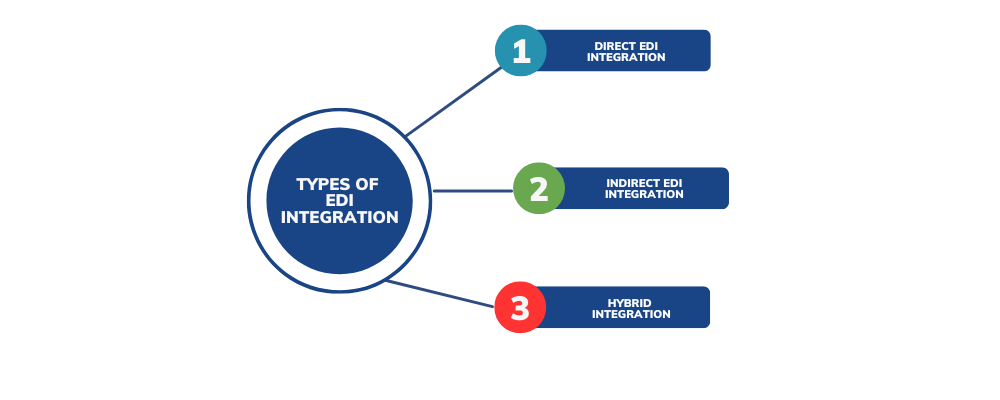
1. Direct EDI integration
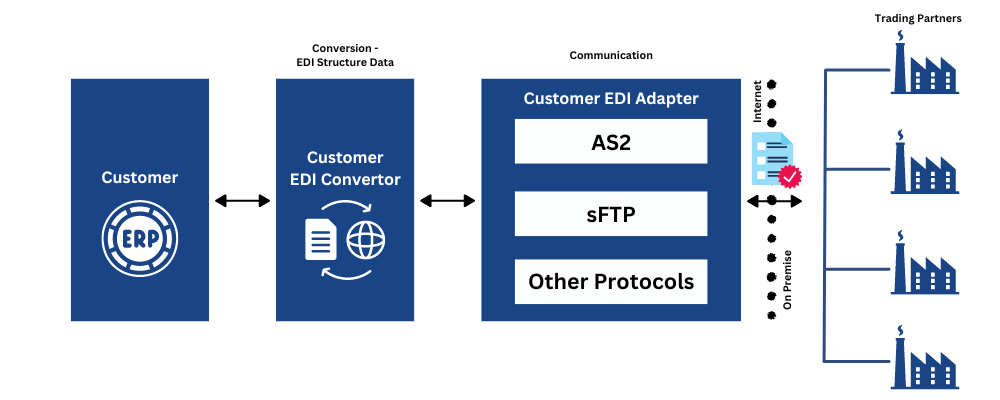
A direct EDI integration uses a specific protocol such as FTP, sFTP, or AS2 to create a point-to-point connection between your trading partners and the Internal ERP or accounting system. In this type of setup, the businesses manage thousands of individual partners’ connections to bring in the data from their trading partners to internal ERP systems. This system becomes too complex to manage as we add more connections and could become difficult to scale or manage over time as your business grows. This type of setup is more suitable for small businesses that only deal with a limited number of trading partners.
2. Indirect EDI Integration
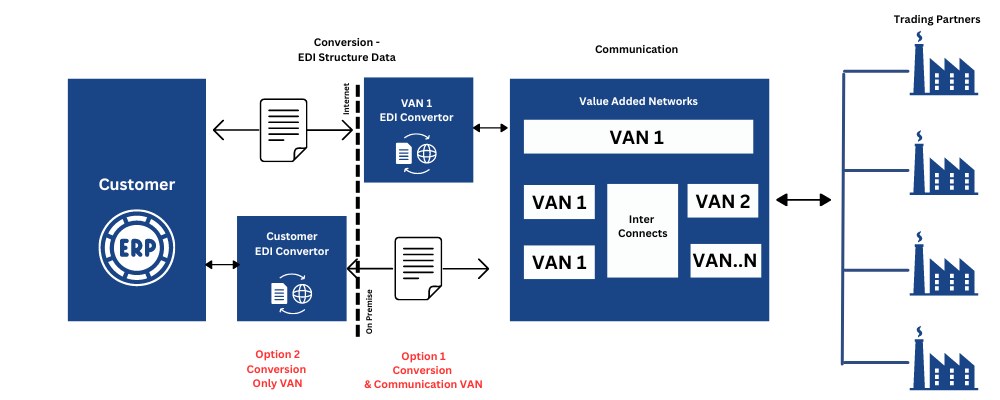
In an indirect EDI integration set up the exchange of communication between your trading partners and ERP is achieved using a 3rd party EDI VAN. First, the message from your ERP system for your trading partner goes out to the VAN and then the VAN splits the message into the format that is preferred by your trading partners and sends it to them. This type of integration is more suitable for medium to large enterprises as they would deal with hundreds of trading partners and they don’t have to set up a separate connection for each one or worry about different protocols to be used, as the VAN can connect to any protocol and transmit the message to the correct trading partner irrespective of the trading partner protocol requirements.
3. Hybrid EDI Integration
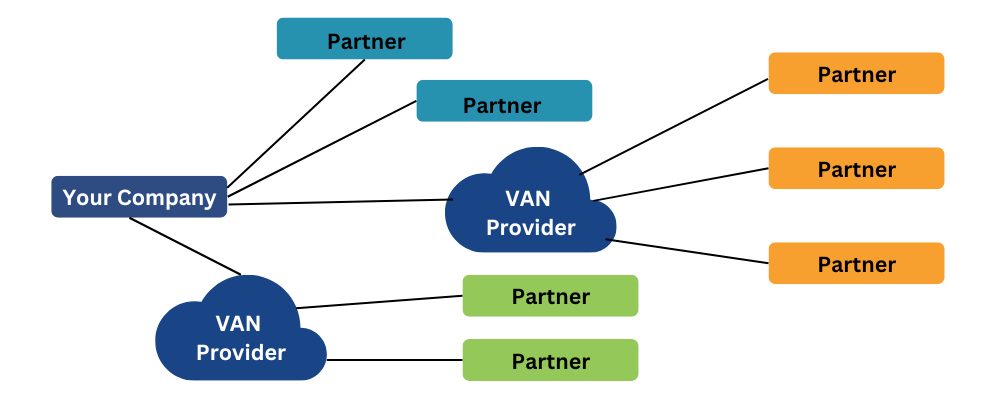
Just like how you have hybrid cars which switch between gasoline and electric to enhance the overall experience and help you save some dollars on gasoline. In a hybrid EDI integration sometimes, companies may need both direct and indirect integration to accommodate various trading partner needs. Like for example if you deal with a specific trading partner with large volumes of data daily it makes sense to connect with them using a direct point-to-point integration to avoid processing delays or connection errors. However, to deal with other small to medium trading partners you can use indirect EDI integration. So, you need a combination of managed EDI service and a point-to-point setup to exchange EDI data.
How Can a EDI Integration Services by Commport Communications Can Help Your Business Operations?
1. Workflow Automation
Helps improve your overall business operations by automating order processing, invoicing, packing, and shipping. Streamlines messaging across multiple trading partners.
2. Data Transparency & Security
A stand-alone centralized system for all your data exchange needs in a standardized format. Easy order tracking with real-time data. Enabling accurate fulfillment, and delivery, reduced errors, and increased sales. Securing the data exchange by using protocols such as AS2 or sFTP and providing world-class support with uninterrupted exchanges. Transaction traceability, redundant in-house data hosting centers, and business continuity and recovery plans.
3. Best Support Services
Using Commport as a EDI vendor for your integrations can help you not only just with integration challenges but also help you manage the entire EDI system, by providing you with onboarding support, implementation, compliance testing, and 24/7 emergency support with error monitoring and issue resolution.
4. Support Multiple Fulfillment Models & Agile
Businesses can have multiple fulfillment models to deliver products to their partners. It could be D2C (direct to consumer), ship to 3PL provider, ship to store directly, ship to distribution center (DC), and many more models. Our Team of EDI experts will ensure 100% complaint with your needs and current technologies.
5. Pre-Built & Established EDI Mapping
Commport has a pre-built mappings with hundreds of trading partners across the world. Complaint with many EDI standards including the most popular standards like ANSI X12 Standard and EDIFACT standards. Because of this existing pre-built mapping, it is faster to connect with the trading partner and start exchanging EDI documents in a few days rather than waiting for weeks or months.
5 Benefits of EDI Integration
- Improved Efficiency: Integrating with EDI eliminates the need for manual data entry, reducing the time and effort required to process business transactions. This can improve operational efficiency and productivity.
- Cost Savings: EDI integration can reduce costs associated with paper-based processes, such as printing, postage, and document storage. Additionally, It also help businesses avoid costly errors and delays caused by manual data entry.
- Better Communication: EDI enables real-time data exchange between systems, improving communication between businesses and their trading partners. This can lead to better collaboration and a more seamless supply chain.
- Increased Accuracy: EDI can help reduce errors and inconsistencies in data by automating data entry and validation. This can help ensure that information is accurate and up to date.
- Scalability: EDI can be easily scaled as businesses grow and their integration needs change. APIs and middle ware can be added or modified to accommodate new systems and applications.
Conclusion
EDI integration can provide significant benefits to businesses looking to improve their supply chain operations. By automating data entry and validation, EDI integration can reduce errors, improve efficiency, and save costs. With the ability to scale and adapt to changing business needs, EDI solutions can be a valuable for businesses of all sizes to improve b2b communication and maintain good relationships with your trading partners.
Want to learn more about EDI?
Here is the complete guide to EDI
Affordable and Top EDI Solution Provider in North America
For over 35 years, Commport Communications has been providing the most affordable and best EDI solutions in the market. By helping companies solve complex integration issues and providing complete EDI communication between business partners.
Commport EDI integration experts can manage all the EDI and B2B integration processes for you, with the flexibility and scale that you truly need. Regardless of how you move your EDI files, Commport will always make sure that you have full access to all your data in real-time, including web-based dashboards, transaction reports, and automated alerts.
Improve your business process and maximize your supply chain performance with our EDI solutions. Contact us today for a free consultation and demo.
Ready to find out more about Commport EDI Solutions?
Need Help? Download: EDI Buyers Guide
Unlock the full potential of your supply chain with our comprehensive EDI Buyer's Guide — your first step towards seamless, efficient, and error-free transactions
Frequently Asked Questions
EDI integration means setting up a full EDI workflow between trading partners to exchange business documents. This includes establishing endpoints, protocols, and EDI document transactions that you exchange with your trading partner and also translating those documents into a format that can be used by your internal order management, ERP, or accounting systems.
There 3 types of EDI integrations
Direct EDI integration, Indirect EDI integration and Hybrid EDI integration.
Here is the list of common communication protocols
FTP, FTPS, sFTP, AS2 and more
ANSI X12, UN/EDIFACT, TRADACOMS, ODETTE, EANCOM, VICS, VDA, RosettaNet, SWIFT

